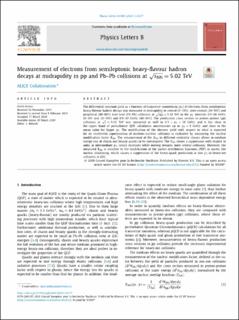Measurement of electrons from semileptonic heavy-flavour hadron decays at midrapidity in pp and Pb–Pb collisions at √sNN=5.02 TeV
Acharya, Shreyasi; Adamová, Dagmar; Adhya, Souvik Priyam; Adler, Alexander; Adolfsson, Jonatan; Aggarwal, Madan M.; Aglieri Rinella, Gianluca; Agnello, Michelangelo; Agrawal, Nikita; Ahammed, Zubayer; Alme, Johan; Altenkaemper, Lucas; Djuvsland, Øystein; Ersdal, Magnus Rentsch; Fionda, Fiorella Maria Celeste; Grøttvik, Ola Slettevoll; Lofnes, Ingrid Mckibben; Nystrand, Joakim; Rehman, Attiq ur; Røhrich, Dieter; Tambave, Ganesh Jagannath; Ullaland, Kjetil; Wagner, Boris; Yang, Shiming; Yuan, Shiming; Zhou, Zhuo; Arsene, Ionut Cristian; Bätzing, Paul Christoph; Dordic, Olja; Lardeux, Antoine Xavier; Lindal, Svein; Mahmood, Sohail Musa; Malik, Qasim Waheed; Richter, Matthias; Røed, Ketil; Skaali, Toralf Bernhard; Tveter, Trine Spedstad; Wikne, Jon Christopher; Zhao, Chengxin; Helstrup, Håvard; Hetland, Kristin Fanebust; Kileng, Bjarte; Nesbø, Simon Voigt; Storetvedt, Maksim Melnik; Langøy, Rune; Lien, Jørgen André; Ahmad, Shafiq F.; Ahn, Sang Un; Akindinov, Alexander; Al-Turany, Mohammed; ALICE, Collaboration
Journal article, Peer reviewed
Published version

Åpne
Permanent lenke
https://hdl.handle.net/11250/2757439Utgivelsesdato
2020Metadata
Vis full innførselSamlinger
Sammendrag
The differential invariant yield as a function of transverse momentum (pT) of electrons from semileptonic heavy-flavour hadron decays was measured at midrapidity in central (0–10%), semi-central (30–50%) and peripheral (60–80%) lead–lead (Pb–Pb) collisions at √sNN = 5.02 TeV in the pT intervals 0.5–26 GeV/c (0–10% and 30–50%) and 0.5–10 GeV/c (60–80%). The production cross section in proton–proton (pp) collisions at √s = 5.02 TeV was measured as well in 0.5 < pT < 10 GeV/c and it lies close to the upper band of perturbative QCD calculation uncertainties up to pT = 5 GeV/c and close to the mean value for larger pT. The modification of the electron yield with respect to what is expected for an incoherent superposition of nucleon–nucleon collisions is evaluated by measuring the nuclear modification factor RAA. The measurement of the RAA in different centrality classes allows in-medium energy loss of charm and beauty quarks to be investigated. The RAA shows a suppression with respect to unity at intermediate pT, which increases while moving towards more central collisions. Moreover, the measured RAA is sensitive to the modification of the parton distribution functions (PDF) in nuclei, like nuclear shadowing, which causes a suppression of the heavy-quark production at low pT in heavy-ion collisions at LHC.
